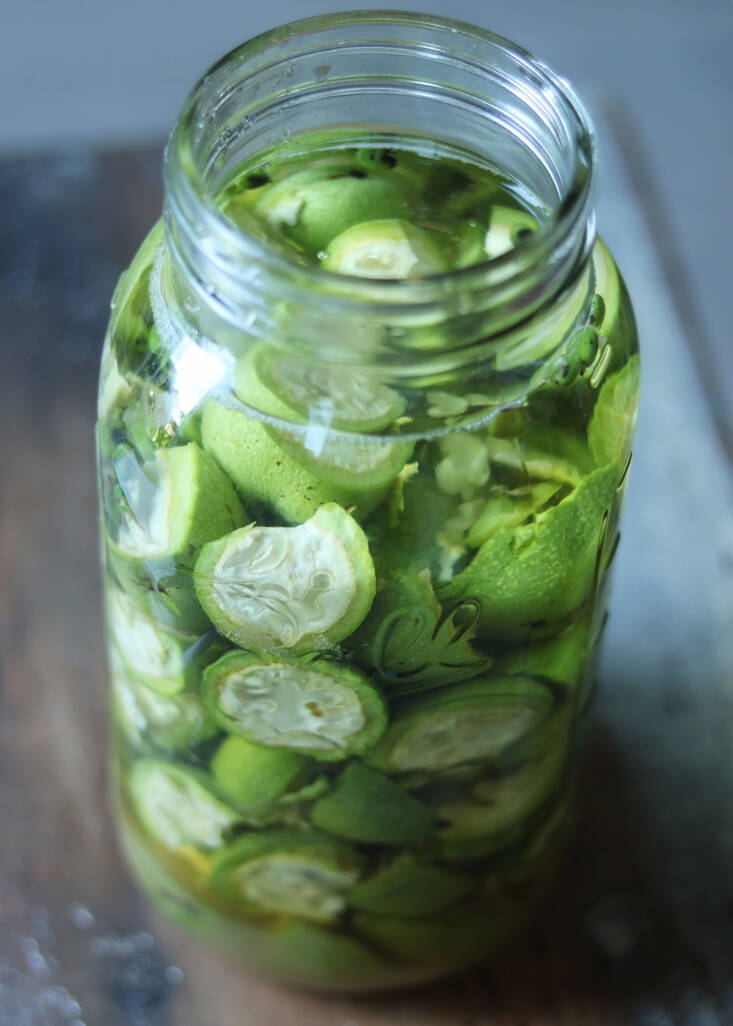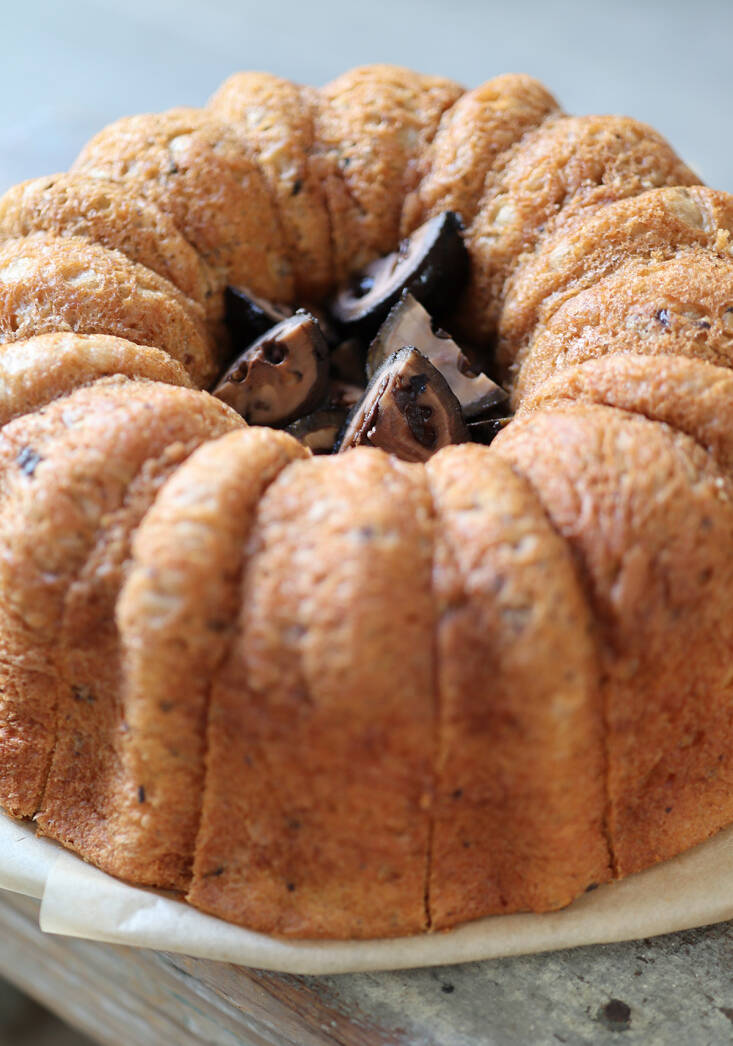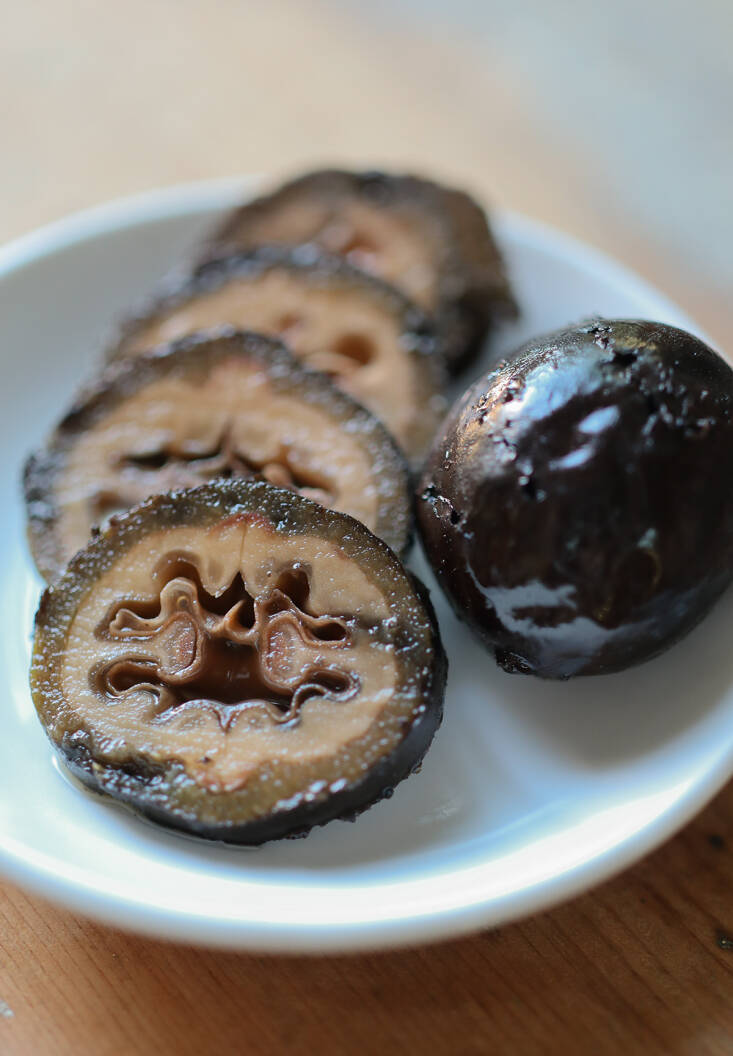Months before they ripen and drop, green walnuts are dramatically aromatic. If you chance upon a walnut tree in summer, reach up and rub a plump, green nut. The scent released is floral, wildly herbal, and instantly uplifting. Apart from that startling aroma, the immature walnuts of midsummer are also arguably easier to process and eat than their late-season iterations, whose tough, dry husks must be shucked to reveal the dry, shell-encased nutmeat within. There are several ways to preserve green walnuts (which always turn oxymoronically black), and walnut pickle recipes abound if you do a quick web-search. But my favorite green walnut preserve is sweet, where the boiled nuts bathe in a thick syrup, whose flavor is unique.
Photography by Marie Viljoen.

My introduction to preserved walnuts was via a tome I turn to often for culinary entertainment, for curiosities, and for lost techniques, preserved: Classic Russian Cooking, by Elena Molokhovets, and translated by Joyce Toomre (see our mugwort story for another mention). Molokhovets’ recipe calls for wooden hairpins, “soft water” and a bladder (we don’t know whose). Otherwise, the recipe makes complete sense for the 21st century. My only adaptation is it to specify baking soda for softening water, and to adjust her method for any amount of nuts, rather than for a specific weight.

The methods for most green walnut preserves have a few steps in common, namely: Soak, boil, steep. Some call for peeling, some for pricking (I prick). And yes, all green walnuts turn deeply black. And, for weeks, so do your fingers, cuticles and nails, unless you wear gloves. Wear gloves.
But before we get to the recipe, more about the walnuts.

The typical nut called for in a green walnut recipe might be Juglans regia, known variously as common walnut, or English walnut. Its green husk has a smooth skin.

In North America native black walnuts (Juglans nigra) abound. They are similarly aromatic, but more powerful, I think, in terms of fragrance, than common walnuts. Black walnuts’ skin is distinctive and rough.

The key to making green walnut preserves or pickles is to collect sufficiently immature nuts. Their interior shell must not have begun to harden within the perfumed, protective green husk. To test whether your nut is perfect to preserve, or too mature (despite being green), slide a skewer or sharp knife (or your wooden hairpin) into its heart. It should meet with no resistance. If the shell has already begun to harden within, you’ll meet that obstacle. Even, then, all is not lost: You could still make a very fragrant and useful syrup from these nuts, but the shell itself will stay hard and will not be fun to eat. But if your skewer/knife/hairpin sails right through, it’s preserve-making time. Collect away.

A traditional European date for collecting green walnuts for nocino, the Italian walnut liqueur, is Summer Solstice.


In the Northeast, black walnuts are still quite tiny (and tufted) on June 21st, but they are a still wonderful ingredient for petite pickles or for the sweet preserves.


After preserving, green walnuts, regardless of species, are tender, candy-like in their sweetness, and aromatic. Serve them entire, as a surprising finalé to a special supper; slice them as a moody garnish for vanilla ice cream; or chop them up and fold into your favorite cake or pancake batter. They even work in savory dishes, pairing beautifully with roasted carrots (served hot or cold), beets, and duck (for example). The syrup is born to be shaken into cocktails, spiked into a hot, aprés-ski coffee, or drizzled over a yeasty savarin, hot from the oven.

Green Walnut Preserves
There are five stages to this recipe: pricking, soaking, boiling, steeping in syrup, and then concentrating the syrup. This method works for any amount of nuts, but be sure to weigh them and to make note of that weight for later. You can use walnuts whose inner shell has begun to form, but then you will be enjoying the fragrant syrup alone, since the shells stay hard after preserving.
- Green walnuts
- Baking Soda
- Sugar
- Spicebush*
- Cinnamon sticks
* Spicebush from Integration Acres is $5 for 1 ounce.
Soaking in Water:
Wear gloves. Using the tines of a fork, prick each walnut all over. Place the nuts in a bowl of water “softened” with baking soda and soak for 10 days. Use ½ teaspoon baking soda for every 1 cup of water. I change the water every other day, but you don’t have to. If you don’t, it will become very dark and Halloween-ishly scummy—that’s normal.
After 10 days, drain and rinse the nuts.
Boiling:
Place the soaked nuts in a pot and cover with water. Again, for every cup of water, add ½ teaspoon of baking soda. Bring the water to a boil, then boil gently until the nuts are barely tender, about 15 to 30 minutes, depending on their size. Drain.
Soaking in Syrup:
Weigh the boiled nuts and place in a sterilized jar(s). Measure the same weight of sugar and the same weight of water. In a pot, boil the sugar and water into a syrup (if you need more syrup to cover, use equal weights sugar and water). Cool. Pour over the nuts in the jar(s). Leave for 3 days.
On Day 4, drain the nuts from the syrup. Pour the syrup into a pot and add the same weight of the original sugar amount to that syrup. (Yes, that’s a lot of sugar!) Bring to a gentle boil, stirring to dissolve the additional sugar. Add spicebush and cinnamon sticks to taste (for 1 lb of nuts I use about 2 teaspoons whole spicebush and 2 cinnamon sticks). Cool. Pour over the nuts in the jar/s again. Store in a coolish, darkish place (like a closet, pantry, or on the floor under a table) for two months, then start sampling. They are at their most unctuous after a year.
See also:
- Wineberries: Invasive—But Delicious to Eat and Drink
- When It’s Hot and Humid, It’s Time to Forage for Chanterelles
- Invasivore: Mugwort the Herb vs. Mugwort the Weed
Frequently asked questions
What are green walnuts?
Green walnuts are walnuts that have not yet fully matured. The nuts inside the green husk are still soft and can be used in cooking and preserving.
How do I harvest green walnuts?
Green walnuts are typically harvested in early summer when the walnuts are still green and the husks are soft. You can gently twist or cut the nuts off the tree branches.
Can I eat green walnuts raw?
Green walnuts are quite bitter and not typically consumed raw. They are usually used in recipes that require cooking or preserving.
How can I preserve green walnuts?
You can preserve green walnuts by making sweet preserves. This involves boiling the walnuts in a sugar syrup until they become tender and flavorful.
What is the recipe for sweet preserves using green walnuts?
The recipe for sweet preserves using green walnuts typically involves boiling the walnuts in a sugar syrup with spices such as cinnamon and cloves. The walnuts are cooked until tender and then preserved in jars.
How long does it take to make sweet preserves with green walnuts?
The process of making sweet preserves with green walnuts usually takes a few days. The walnuts need to be soaked in water, boiled in sugar syrup, and allowed to rest for a day or two to develop flavor before being preserved in jars.
What can I use sweet preserves with green walnuts for?
Sweet preserves with green walnuts can be used as a topping for toast, pastries, or yogurt. They can also be used in baking or added to cheese boards for a unique flavor.
How long can I store sweet preserves with green walnuts?
If properly preserved and sealed in jars, sweet preserves with green walnuts can be stored for several months in a cool, dark place. Once opened, they should be refrigerated and consumed within a few weeks.








Have a Question or Comment About This Post?
Join the conversation